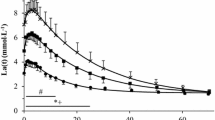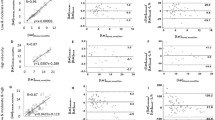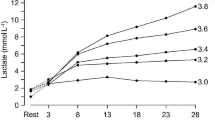Abstract
After exercise the lactate (La) removal from blood occurs significantly faster during moderate exercise than at rest. However, under both conditions there are considerable inter-individual differences in La removal. These differences in man may depend on the slow-twitch (ST) fiber content of muscle (X1), the La concentration in blood (X2), and the intensity of the recovery exercise (X3). Therefore, multiple regression models were obtained to describe La removal rates with these variables. In 10 women La concentrations were increased via a 6 min bicycle ergometer ride (87%VO2 max) and blood La concentrations were measured every 5 min during 20 min resting and active recovery periods (29–49%VO2 max). For resting recovery only the initial La concentration after the 6 min exercise provided a significant description for La removal in 8 subjects (P=0.03). However, for the active recovery a highly significant description for La removal was obtained: La removal rate (mM/l · min)=0.773×10−2X1+0.321×10−1X2−0.120×10−1X3+0.202 (R=0.91;P=0.01). The statistical independence (P>0.10) of each of these variables in the model suggests that each is contributing uniquely to the total removal rate of La observed during an active recovery period. The relationship between La removal and %ST fibers may be related to the metabolic and anatomical features of these fibers, the La concentration probably reflects the significance of the mass action effect of La, and the intensity of exercise reflects the role of the muscle's metabolic rate. The present results illustrate that the removal of blood lactate is influenced by the interactive effects of the intensity of the recovery exercise, blood lactate concentration and the ST fiber content of muscle.
Similar content being viewed by others
References
Ahlborg, G., Hagenfeldt, L., Wahren, J.: Substrate utilization by the inactive leg during one-leg or arm exercise. J. Appl. Physiol.39, 718–723 (1979)
Ahlborg, G., Hagenfeldt, L., Wahren, J.: Influence of lactate infusion on glucose and FFA metabolism in man. Scand. J. Clin. Lab. Invest.36, 193–201 (1976)
Anderson, P.: Capillary distribution in skeletal muscle of man. Acta Physiol. Scand.95, 203–205 (1975)
Belcastro, A. N., Bonen, A.: lactic acid removal rates during controlled and uncontrolled recovery exercise. J. Appl. Physiol.39, 932–937 (1975)
Bergstrom, J.: Muscle electrolytes in man. Scand. J. Clin. Lab. Invest. Suppl. 68 (1962)
Bonen, A., Belcastro, A. N.: Accuracy of a dry gas meter to monitor ventilation during exercise. Br. J. Sports Med.8, 181–182 (1974)
Bonen, A., Belcastro, A. N.: Comparison of self-selected recovery methods on lactic acid removal rates. Med. Sci. Sports8, 176–178 (1976)
Bonen, A., Campbell, C. J., Kirby, R. L., Belcastro, A. N.: Relationship between slow-twitch muscle fibers and lactic removal. Can. J. Appl. Sport Sci.3, 160–162 (1978)
Dieterle, P., Banholzer, P., Dieterle, R., Henner, J., Schwartz, K.: The influence of lactate on muscle metabolism. Lactate as a possible regulating factor for the increased energy supply during muscular work. Horm. Metab. Res.3, 340–344 (1971)
Depocas, F., Minaire, Y., Chatonnet, J.: Rates of formation and oxidation of lactic acid in dogs at rest and during exercise. Can. J. Physiol. Pharmacol.47, 603–610 (1969)
Dubowitz, V., Brooke, M. H.: Muscle Biopsy: A Modern Approach, pp. 20–33. London: W. B. Saunders 1973
Eldridge, F. L.: Relationship between turnover rate and blood concentration of lactate in exercising dogs. J. Appl. Physiol.39, 231–234 (1975)
Essen, B., Pernow, B., Gollnick, P. D., Saltin, B.: Muscle glycogen content and lactate uptake in exercising muscle. In: Metabolic adaptation to prolonged physical exercise. (H. Howald and J. R. Poortmans, eds.), pp. 130–134. Basel: Birkhauser, 1975
Gollnick, P. D., Armstrong, R. B.: Histochemical localization of lactate dehydrogenase isozymes in human skeletal muscle fibers. Life Sci.18, 23–32 (1976)
Hermansen, L., Stensvold, I.: Production and removal of lactate during exercise in man. Acta Physiol. Scand.86, 191–201 (1972)
Hermansen, L., Vaage, O.: Lactate disappearance and glycogen synthesis in human muscle after maximal exercise. Am. J. Physiol.233, E422-E429 (1977)
Hermansen, L., Machlum, S., Pruett, E. D. R., Vaage, O., Waldhum, E., Wessel-Aas, T.: Lactate removal at rest and during exercise. In: Metabolic adaptation to prolonged physical exercise (H. Howald and J. R. Poortmans, eds.), pp. 101–105. Basel: Birkhäuser 1975
Issekutz, B., Miller, H.: Plasma free fatty acids during exercise and the effect of lactic acid. Proc. Soc. Exp. Biol.110, 237–242 (1962)
Issekutz, B., Shaw, W. A. S., Issekutz, A. C.: Lactate metabolism in resting and exercising dogs. J. Appl. Physiol.40, 312–319 (1976)
Jorfeldt, L.: Metabolism of L(+)-lactate in human skeletal muscle during exercise. Acta Physiol. Scand., Suppl. 338 (1970)
Jorfeldt, L., Juhlin-Dannfelt, A., Karlsson J.: Lactate release in relation to tissue lactate in human skeletal muscle during exercise. J. Appl. Physiol. Environ. Exercise Physiol.44, 350–352 (1978)
Karlsson, J., Frith, K., Sjödin, B., Gollnick, P. D., Saltin, B.: Distribution of LDH isozymes in human skeletal muscle. Scand. J. Clin. Lab. Invest.33, 307–312 (1974)
Karlsson, J., Sjödin, B., Thorstensson, A., Hulten, B., Frith, K.: LDH isozymes in skeletal muscle of endurance and strength trained athletes. Acta Physiol. Scand.93, 150–156 (1975)
Kerlinger, F. N., Pedhazur, E. J.: Multiple Regression in Behavioral Research, pp. 53–81. New York: Holt, Rinehart and Winston 1973
McGrail, J. C., Bonen, A., Belcastro, A. N.: Dependence of La removal on muscle metabolism in man. Eur. J. Appl. Physiol.39, 87–97 (1978)
Nemoto, E. M., Hoff, J. T., Severinghaus, J. W.: Lactate uptake and metabolism by brain during hyperlactataemia and hypoglycemia. Stroke5, 48–53 (1974)
Rowell, L. B., Kraning II, K. K., Evans, T. O., Kennedy, J. W., Blackmon, J. R., Kusmi, F.: Splanchnic removal of lactate and pyruvate during exercise in man. J. Appl. Physiol.21, 1773–1783 (1966)
Sjödin, B.: Lactate dehydrogenase in human skeletal muscle. Acta Physiol. Scand., Suppl. 436 (1976)
Spitzer, J. J.: Effect of lactate infusion on canine myocardial free fatty acid metabolism in vivo. Am. J. Physiol.226, 213–217 (1974)
Yudkin, J., Cohen, R. D.: The contribution of the kidney to the removal of lactic acid under load under normal and acidotic conditions in the conscious cat. Clin. Sci. Mol. Med.46, 8P (1974)
Author information
Authors and Affiliations
Rights and permissions
About this article
Cite this article
Bonen, A., Campbell, C.J., Kirby, R.L. et al. A multiple regression model for blood lactate removal in man. Pflugers Arch. 380, 205–210 (1979). https://doi.org/10.1007/BF00582897
Received:
Issue Date:
DOI: https://doi.org/10.1007/BF00582897




